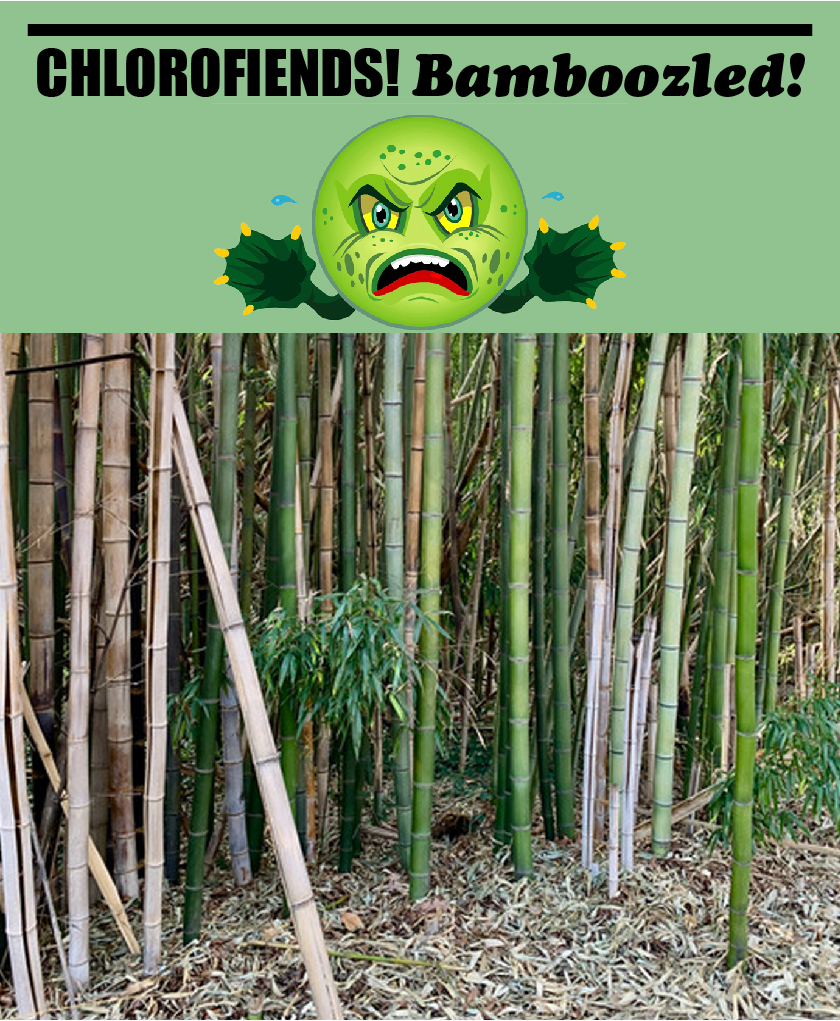By Lisa Lofland Gould
Gentle wind chimes … tasty shoots … fishing poles … Panda bears … bamboo has meaning and value to so many people (and other animals) around the world. When bamboo is moved from its home of origin to areas where it did not evolve, however, it can become a serious problem, a nightmare for homeowners and ecosystems alike.
Who hasn’t admired a stand of swaying bamboo or delighted in a delicate Chinese painting of bamboo? Few other plants have so much utility for people—bamboos are edible, can be used for furniture and building materials, and have been seen as symbols of strength, perseverance, prosperity, and beauty. And few other plants, when taken out of their natural habitats and moved to other parts of the world, can so completely eradicate native competitors as thoroughly as bamboo can.
There are over 1,200 species of bamboo in the world, found naturally in southern and southeast Asia, Oceania, Africa, South and Central America, and southeast and tropical North America. In the grass family, some bamboos are herbaceous and others woody (although the “woodiness” of bamboo differs from the wood of woody trees, shrubs, and vines). Bamboos can also be divided into clumping forms and running forms; it’s primarily the running forms that spread rapidly and become invasive.
A number of Asian bamboos have been introduced as ornamental plants here in North Carolina and several of them are spreading. The most common one is Golden Bamboo (Phyllostachys aurea), also called Fishpole Bamboo, a running bamboo that can form huge colonies where few other plants can grow (although I have seen English Ivy (Hedera helix) growing with Golden Bamboo—wouldn’t you know?!).
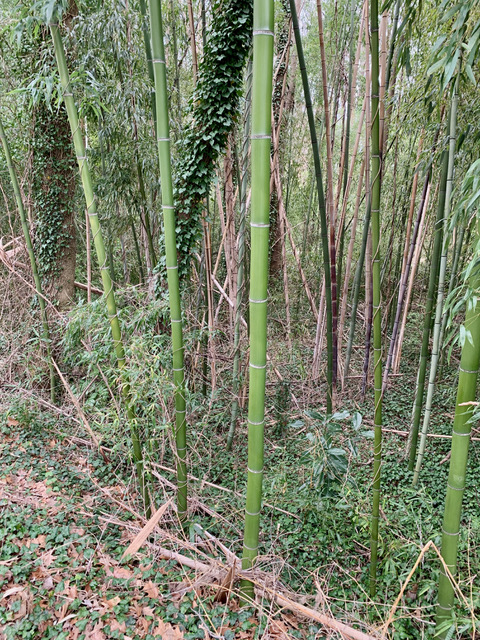
Not only does a stand of Golden Bamboo create dense shade, but papery sheaths that fall away from the stems litter the ground within a stand and further suppress the growth of native plants.
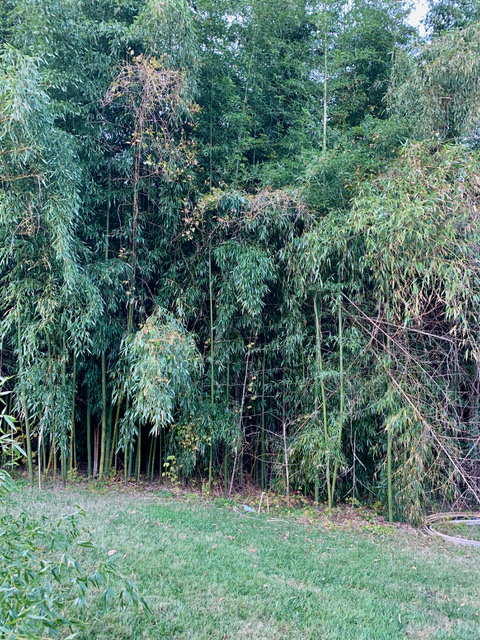
Golden Bamboo can reach over 40’ in height, with the hollow stems up to 6” around. Giant Timber Bamboo (Phyllostachys bambusoides), found escaping in two NC counties, is even larger, growing up to 60’ tall.
Several other running Phyllostachys species are beginning to spread in the Southeast, as is Arrow Bamboo (Pseudosasa japonica), a Japanese native that has escaped from cultivation in the North Carolina mountains and piedmont. Hedge Bamboo (Bambusa vulgaris) is not yet documented in North Carolina but has been found naturalizing in Virginia. Alan Weakley, curator of the UNC Herbarium, notes that we don’t really know the full extent of the Asian bamboos’ spread, as few are documented as herbarium specimens (try pressing a 12’ stem of Golden Bamboo!) and since these plants rarely flower, making pressed specimens of the flowering parts is also difficult.
Roots Penetrate Driveways and Sidewalks
What makes these grasses so tenacious? They have very dense root systems, with rhizomes that send up new shoots from nodes; these shoots are so tough they can penetrate sidewalks and driveways. Bamboos are also very fast growing and can thrive in marginal soils, making them excellent colonizers.
With no natural enemies in their adopted lands, there is little to keep them at bay.
Bamboo is Flammable and Can Explode
For homeowners there is another big concern: fire hazard. While green bamboo may not be terribly flammable, the dried stems, leaves, and sheaths are, and I’ve yet to see a bamboo stand that did not include lots of dead stems and dried debris. Bamboo can explode when burned, spreading fire farther from the stand. I would not want to be the owner of this home near me
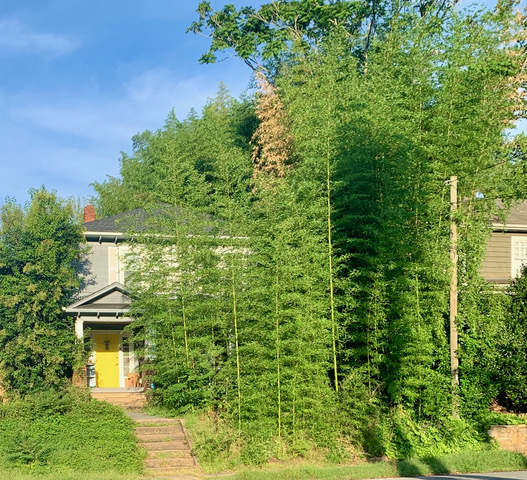
—both for fire safety and property value concerns—with bamboo spreading on three sides of the house.
A couple of other non-native plants are called “bamboo” but are not related to the true bamboos. Nandina (Nandina domestica), in the barberry family, is also known as Sacred or Heavenly Bamboo. Nandina appears to be on its way to becoming an invasive in North Carolina.
Japanese Knotweed (Reynoutria japonica), in the buckwheat family, is sometimes called Japanese Bamboo. Japanese Knotweed is a well-known problem around the world, as difficult to eradicate and as damaging to North American ecosystems as the Asian bamboos.
Because bamboo is famous for its rapid growth—invasive non-native Golden Bamboo is said to be able to grow 3’ in 24 hours—and its ability to sequester carbon, some people are advocating planting it to combat climate change. Will we never learn?!? Kudzu (Pueraria montana) and Bicolor Lespedeza (Lespedeza bicolor), to name just two infamous invaders deliberately introduced here in the South, were initially planted for erosion control, but look at their impact on our local ecosystems!
Surely by now we should be smart enough to find native plants to mitigate problems: for erosion control, wherever you are in the world, plant native nitrogen fixers instead of exotic ones, and to mitigate an overabundance of carbon dioxide, utilize native plants that grow rapidly and store carbon.
Potential Use for Native Bamboos
What about using our native bamboos, for example? North Carolina is home to three species: Giant Cane (Arundinaria gigantea)
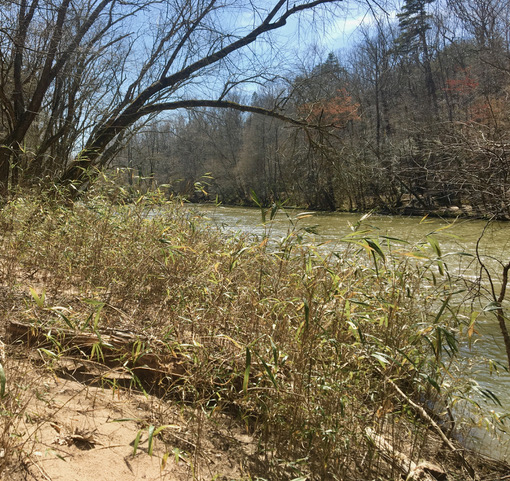
Switch Cane (Arundinaria tecta, sometimes lumped as a variety of A. gigantea), and Hill Cane (Arundinaria appalachiana). Giant Cane grows across the state, while Switch Cane is present in the NC piedmont and coastal plain; both grow in moist to wet habitats. Hill Cane, the shortest of these species, grows on forested slopes in dry to mesic mountain soils. Like the Asian bamboos they seldom flower, grow by rhizomes, and can form large colonies or “canebreaks”.
Know How to Control It Before You Plant It
It takes a strong will and a stronger back to control a stand of native bamboo, and an even stronger effort to remove non-native bamboo. Before planting any plant, you need to understand its growth habits. The clumping bamboos are sometimes grown in containers, but when they are planted in the ground, they can slowly form bigger and bigger clumps. Some homeowners have dealt with this (labor intensively) by digging a deep trench around the clump, lining it with sturdy fiberglass, and then monitoring the clump to be sure that no shoots break through the barrier.
Spreading bamboo is much tougher to control. Biological control—control by introducing pests or diseases native to an invasive species—is not currently available, so both mechanical and chemical methods are typically used. It’s possible to eradicate a small stand with repeated mowing and digging up the rhizomes (this may take several years); larger stands may need power equipment and possibly treatment with herbicides (a strong concentration of glyphosate is usually recommended), with spraying the leaves in autumn and then repeated spraying on new growth. Cut stem treatments with herbicides may also be done.
Our native bamboos—canes—are very valuable to our wildlife, providing dense cover and nesting sites, as well as serving as host plants for at least six species of butterflies, but are best left in natural settings. Might Giant Cane be a good candidate for carbon sequestration? Let’s hope that good brains in our universities and colleges will research such a possibility.
More specific information for bamboo control can be found at Clemson University, invasive.org, and the Missouri Botanical Garden.
In the long run, the best way to control exotic bamboo is to not plant it in the first place—as always, GO NATIVE!
By Lisa Lofland Gould
Native Plant News – Summer 2022

Lisa Gould is a plant ecologist and co-founder of the Rhode Island Wild Plant Society; she currently serves on the NCNPS board of directors and chairs the management committee for the Emily Allen Wildflower Preserve in Winston-Salem.
Chlorofiends! is a regular column in Native Plant News. If you have information or comments on invasive species in North Carolina, please share them with Lisa Gould (lisalgould@gmail.com).
*Thanks to Jim Butcher’s The Dresden Files for the column title.
